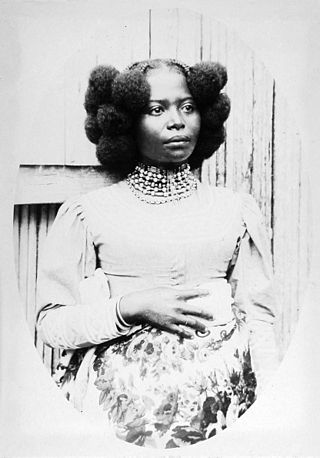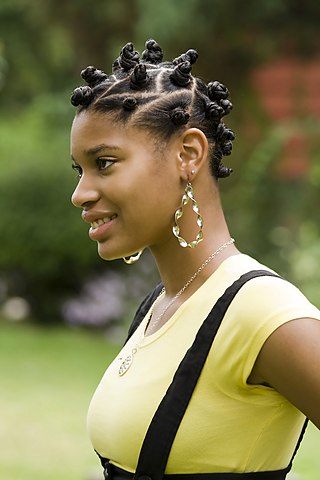
A hairstyle, hairdo, haircut or coiffure refers to the styling of hair, usually on the human head but sometimes on the face or body. The fashioning of hair can be considered an aspect of personal grooming, fashion, and cosmetics, although practical, cultural, and popular considerations also influence some hairstyles.

Dreadlocks, also known as dreads or locs, are a hairstyle made of rope-like strands of hair. This is done by not combing the hair and allowing the hair to mat naturally or by twisting it manually. Over time the hair will form tight braids or ringlets.

A braid is a complex structure or pattern formed by interlacing three or more strands of flexible material such as textile yarns, wire, or hair. The simplest and most common version is a flat, solid, three-stranded structure. More complex patterns can be constructed from an arbitrary number of strands to create a wider range of structures. The structure is usually long and narrow with each component strand functionally equivalent in zigzagging forward through the overlapping mass of the others. It can be compared with the process of weaving, which usually involves two separate perpendicular groups of strands.

Cosmetology is the study and application of beauty treatment. Branches of specialty include hairstyling, skin care, cosmetics, manicures/pedicures, non-permanent hair removal such as waxing and sugaring, and permanent hair removal processes such as electrology and intense pulsed light (IPL).

The afro is a hair style created by combing out natural growth of afro-textured hair, or specifically styled with chemical curling products by individuals with naturally curly or straight hair. The hairstyle can be created by combing the hair away from the scalp, dispersing a distinctive curl pattern, and forming the hair into a rounded shape, much like a cloud or puff ball.

Cornrows are a style of traditionally three-strand braids, originating in Africa, in which the hair is braided very close to the scalp, using an underhand, upward motion to make a continuous, raised row. Cornrows are often done in simple, straight lines, as the term implies, but they can also be styled in elaborate geometric or curvilinear designs. They are distinct from, but may resemble, box braids, Dutch braids, melon coiffures, and other forms of plaited hair, and are typically tighter than braids used in other cultures.

Marjorie Joyner was an American businesswoman, hair care entrepreneur, philanthropist, educator, and activist. Joyner is noted for being the first African-American woman to create and patent a permanent hair-wave machine. In addition to her career in hair care, Joyner was highly visible in the African-American community in Chicago, once serving as head of the Chicago Defender Charity network, helping organize the Bud Billiken Day Parade and fundraiser for various schools.

Kinky hair, also known as afro-textured hair, is a human hair texture prevalent in the indigenous populations of many regions with hot climates, mainly sub-Saharan Africa, and some areas of Melanesia, and Australia. Each strand of this hair type grows in a repeating pattern of small contiguous kinks. These numerous kinks make kinky hair appear denser than straight, wavy, and curly hair types.

The Madam C. J. Walker Manufacturing Company was a cosmetics manufacturer incorporated in Indianapolis, Indiana in 1910 by Madam C. J. Walker. It was best known for its African-American cosmetics and hair care products, and considered the most widely known and financially successful African-American-owned business of the early twentieth century. The Walker Company ceased operations in July 1981.

African-American hair or Black hair refers to hair types, textures, and styles that are linked to African-American culture, often drawing inspiration from African hair culture. It plays a major role in the identity and politics of Black culture in the United States and across the diaspora. African-American hair often has a kinky hairy texture, appearing tightly coiled and packed. Black hair has a complex history, culture, and cultural impact, including its relationship with racism.

Hair twists, flat twists, or mini-twists, are a hairstyle popular with Afro-textured hair around the world, and sometimes with other hair textures. The style is achieved by dividing the hairs into several sections, twisting strands of hair, then twisting two twisted strands around one another. They can also be created with one strand of hair at a time, with a comb. They are not to be confused with larger, longer dreadlocks,.
Discrimination based on hair texture, also known as textureism, is a form of social injustice, where afro-textured hair or coarse hair types, and their associated hair styles, are viewed negatively, often perceived as "unprofessional", "unattractive", or "unclean". This view can lead, for example, to some school students being excluded from class.

Crochet braids, also known as latch hook braids, are techniques for braiding hair that involve crocheting synthetic hair extensions to a person's natural hair with a latch hook or crochet hook. While crochet braids are a hybrid of traditional braids, they're considered to be more similar to weaves. This method is associated with African hair styles. Known as a protective style, the technique can assist with hair growth if cared for properly. Crochet braids can be worn straight, curly, twisted, or braided.
The natural hair movement is a movement which aims to encourage people of African descent to embrace their natural, afro-textured hair; especially in the workplace. It originated in the United States during the 1960s, and resurged in popularity in the 2000s.

Box braids are a type of hair-braiding style that is predominantly popular among African people and the African diaspora. This type of hairstyle is a "protective style" and is "boxy", consisting of square-shaped hair divisions. Box braids are generally installed by using synthetic hair which helps to add thickness as well as helping the natural hair that is in the braid. Because they are not attached to the scalp like other similar styles such as cornrows, box braids can be styled in a number of different ways. The installation process of box braids can be lengthy, but once installed they can last for six to eight weeks. They are known for being easy to maintain.

Braids are a complex hairstyle formed by interlacing three or more strands of hair. Braiding has been used to style and ornament human and animal hair for thousands of years in various cultures around the world.
In the United States, discrimination based on hair texture is a form of social injustice that has been predominantly experienced by African Americans and predates the founding of the country.

A protective hairstyle is a term predominantly used to describe hairstyles suitable for Afro-textured hair. These hairstyles are designed to minimize manipulation and exposure of the hair to environmental elements. Factors such as extreme temperatures, humidity, and precipitation can adversely affect hair health. Protective hairstyles are beneficial in mitigating these effects by keeping the hair tucked away and reducing its exposure to potentially damaging conditions.

Rogers v. American Airlines was a 1981 legal case decided by the United States District Court for the Southern District of New York involving plaintiff Renee Rogers, a Black woman who brought charges against her employer, American Airlines, for both sex and race discrimination after she was dissuaded from wearing her hair in cornrows due to the airline's employee grooming policy. Rogers believed that this hair policy was a violation of her Title VII rights.

The Creating a Respectful and Open World for Natural Hair Act of 2022 was a bill in the United States Congress intended to prohibit discrimination based on an individual's hair texture or hairstyle by classifying such discrimination illegal under federal law. It applied to federally assisted programs, housing programs, public accommodations, and employment. The act was introduced in the House of Representatives by Congresswoman Bonnie Watson Coleman (D-NJ) on March 19, 2021. Senator Cory Booker (D-NJ) introduced a companion bill in the Senate on March 22, 2021. The CROWN Act of 2022 marked the second time the legislation was introduced in Congress.



























